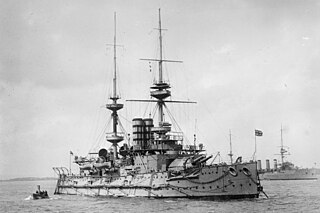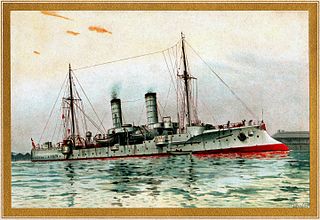
The battlecruiser was a type of capital ship of the first half of the 20th century. These were similar in displacement, armament and cost to battleships, but differed in form and balance of attributes. Battlecruisers typically had thinner armour and a somewhat lighter main gun battery than contemporary battleships, installed on a longer hull with much higher engine power in order to attain greater speeds. The first battlecruisers were designed in the United Kingdom, as a development of the armoured cruiser, at the same time as the dreadnought succeeded the pre-dreadnought battleship. The goal of the design was to outrun any ship with similar armament, and chase down any ship with lesser armament; they were intended to hunt down slower, older armoured cruisers and destroy them with heavy gunfire while avoiding combat with the more powerful but slower battleships. However, as more and more battlecruisers were built, they were increasingly used alongside the better-protected battleships.

The Majestic class of nine pre-dreadnought battleships were built for the Royal Navy in the mid-1890s under the Spencer Programme, named after the First Lord of the Admiralty, John Poyntz Spencer. With nine units commissioned, they were the most numerous class of battleships. The nine ships, HMS Majestic, Caesar, Hannibal, Illustrious, Jupiter, Magnificent, Mars, Prince George, and Victorious, were built between 1894 and 1898 as part of a programme to strengthen the Royal Navy versus its two traditional rivals, France and Russia. This continued the naval re-armament initiatives begun by the Naval Defence Act 1889.

The Canopus class was a group of six pre-dreadnought battleships of the British Royal Navy built in the late 1890s. The ships were designed by the Director of Naval Construction, William White, for use on the China Station. The class comprised Canopus, the lead ship, and Glory, Albion, Ocean, Goliath, and Vengeance. The class was armed with a main battery of four BL 12 inch Mk VIII naval guns and a secondary battery of twelve QF 6-inch guns. Compared to the preceding Majestic-class battleships, the Canopus class was smaller, faster, and less heavily armoured, though they adopted new, stronger Krupp armour, which was more effective than the Harvey steel used in the Majestics. In addition to the Krupp steel, the ships also adopted several other changes, including water-tube boilers, in-line funnels, and a full-length armoured belt.

The C class was a group of twenty-eight light cruisers of the Royal Navy, and were built in a sequence of seven groups known as the Caroline class, the Calliope class, the Cambrian class, the Centaur class, the Caledon class, the Ceres class and the Carlisle class. They were built for the rough conditions of the North Sea, and proved to be rugged and capable vessels, despite being somewhat small and cramped.

The Cressy-class cruiser was a class of six armoured cruisers built for the Royal Navy around 1900. Their design's incorporation of a pair of 9.2-inch guns and armoured sides served to address criticism directed against the previous Diadem class — advances made possible by their 1,000 ton increase in displacement over their predecessors. The ships were notably stable, except for a susceptibility to pitching.

The Devonshire-class cruiser was a group of six armoured cruisers built for the Royal Navy in the first decade of the 20th century. All ships of the class served in World War I. Argyll was wrecked, and Hampshire was sunk by a naval mine. The four survivors were disposed of soon after the war.

The Monmouth class was a ten-ship class of 10,000-ton armoured cruisers built around 1901 to 1903 for the Royal Navy and designed specifically for commerce protection. The ships were also referred to as County class cruisers as they carried the names of British counties.

The Duke of Edinburgh-class cruiser was a class of two armoured cruisers built for the Royal Navy in the first decade of the 20th century. They were the first British armoured cruisers designed to work with the battlefleet rather than protect merchant shipping. After commissioning, they were assigned to the Atlantic, Channel and Home Fleets until 1913 when they were transferred to the Mediterranean Fleet. After the start of World War I in August 1914, the sister ships participated in the pursuit of the German battlecruiser SMS Goeben and light cruiser SMS Breslau. After the German ships reached their refuge in Ottoman Turkey, the ships were ordered to the Red Sea for convoy escort duties. They captured three German merchant ships before they returned to home at the end of the year.
Imperial Japanese Navy submarines originated with the purchase of five Holland type submarines from the United States in 1904. Japanese submarine forces progressively built up strength and expertise, becoming by the beginning of World War II one of the world's most varied and powerful submarine fleets.

The A-class torpedo boats were a class of German single-funnelled torpedo boat/light destroyer designed by the Reichsmarineamt for operations off the coast of occupied Flanders in the First World War. The "A" designation was to avoid confusion with older classes and designs. They were classed officially as "coastal torpedo boats" to differentiate from larger, ocean-going torpedo boats.

The Bayan class was a group of four armored cruisers built for the Imperial Russian Navy around the beginning of the 20th century. Two of the ships were built in France, as Russian shipyards had no spare capacity. The lead ship, Bayan, was built several years earlier than the later three. The ship participated in several of the early naval battles of the Russo-Japanese War of 1904–05, and provided naval gunfire support for the Imperial Russian Army until she struck a mine. Bayan was trapped in harbor during the subsequent Siege of Port Arthur, and was sunk by Japanese artillery. She was salvaged and put into service with the Imperial Japanese Navy with the name of Aso. She mostly served as a training ship before she was converted into a minelayer in 1920. The ship was sunk as a target in 1932.

The S class was a class of 67 destroyers ordered for the Royal Navy in 1917 under the 11th and 12th Emergency War Programmes. They saw active service in the last months of the First World War and in the Russian and Irish Civil Wars during the early 1920s. Most were relegated to the reserve by the mid-1920s and subsequently scrapped under the terms of the London Naval Treaty. Eleven survivors saw much action during the Second World War.

HMS Sirius was an Apollo-class cruiser of the British Royal Navy which served from 1892 to 1918 in various colonial posts such as the South and West African coastlines and off the British Isles as a hastily converted minelayer during the First World War.

The Gazelle class was a group of ten light cruisers built for the Imperial German Navy at the turn of the 20th century. They were the first modern light cruiser design of the Imperial Navy, and set the basic pattern for all future light cruisers in Imperial service. The design of the Gazelle class attempted to merge the fleet scout with the colonial cruiser. They were armed with a main battery of ten 10.5 cm (4.1 in) guns and a pair of torpedo tubes, and were capable of a speed of 21.5 knots.













